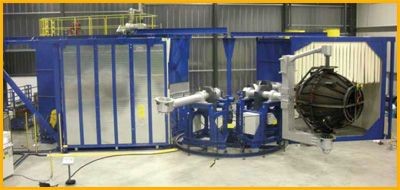

Rotational moulding (also known as rotomoulding) does not involve the use of a plasticising unit. Instead of injecting or extruding molten material under pressure, the process uses materials such as powdered polyethylene that are cast within a hollow tool.

A multi-arm rotational moulding machine with heating and cooling stations.
The tool is typically constructed from aluminium or sheet steel and is manually opened and closed to fill with powder and remove the finished part. The usual process is:
Rotational moulding is a labour intensive and relatively slow process, so multiple tools are typically cycled through the various stages. To achieve this, the machine can have up to 4 separate arms. Shuttle machines move the tool in a linear manner through the stations, so only tend to have one or two arms, but swing and carosel designs can be more complex.
Visit here to contact the leading UK companies that can provide you with advice and quotes for your rotational moulding machine requirements.